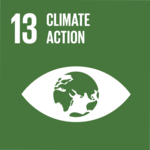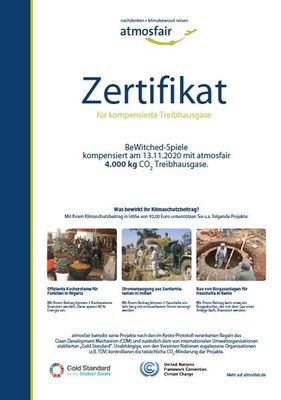BeWitched
Why do games matter when it comes to climate action?

Burning fossil fuels, agriculture and dealing with our waste contribute to greenhouse gas emissions and thus to climate change and global warming. When you buy a shrink-wrapped board- or cardgame, you also buy greenhouse gas emissions. This starts with the clear plastic film, continues with cardboard and paper for board, cards and rules, the production of which consumed energy, and does not stop with the transport of the game's components to the producer. Understanding the full chain of delivery is usually complex and often costly. Some producers offer this service to game publishers, other do not understand the question.
However, only those who know which raw materials and which (fossil) energy wer used for the production of a game are at least partly able to calculate the greenhouse gas emission the production has caused. And only if you know that, you can offset the emissions you could not avoid by paying money for climate action projects.
You can find further information on climate action at Skeptical Science, hints for offsetting can be found at Carbon Footprint.
Why does BeWitched-Spiele root for climate action?

In order to comply with the United Nations Paris Agreement, all member states have to be greenhouse gas neutral by the second half of the century, industrialized countries even earlier. Germany decided in its Federal Climate Act to aim at greenhouse gas neutrality by 2050.
This means that if possible all production processes need to work without emitting greenhouse gases. Energy production needs to become independent of fossil fuels such as coal, gas and oil even earlier, For this we need to save energy and raise energy efficiency. Besides, we need to extend our use of renewable energies massively. What is more: if we want to continue our energy-intensive industrial processes, we will need a lot more renewable energy than all the energy we use today.
It also means that game production as a whole has to be "decarbonized" and more energy efficient. This will not happen automatically, but only if customers such as - the admittedly very small publisher - Bewitched-Spiele demand it. Nonetheless we can set a sign together by producing Hossa GHG neutrally and by buying and playing it, of course ;-). Of course I do hope that other and bigger publishers will follow my example.
Greenhouse gas neutral production of Hossa

The new edition of Hossa was produced greenhouse gas neutral wherever possible.
This means that I asked the producer LudoFact and the artist Christof Tisch for information which power they use and which paper products, colours, finish and plastic film will be used in which amounts. The produced games were transported form the production to the storage facility of LudoPackt next to it by electric forklifts using renewable energy.
I did not include the chain of delivery of the production of colours and paper or ingredients such as machine oil etc.
Neither did I include transportation from LudoPackt to retailers and customers nor disposal of the games, should anybody throw the game away.
I had to estimate or derive the factors for the CO2-emissions from the production of the components, because so far LudoFact does not know the carbon footprint of its products or their components. However, as more and more customers demand GHG neutral products, I am sure that this will change in the foreseeable future.
Power
Both Ludofact and Christof Tisch use power generated by 100% renewables. I myself use renewable energy from EWS, so that the electric power used did not produce any greenhouse gas emissions.
Generally using fossil electricity causes the most part of greenhouse gas emissions.
Paper
As everybody contributing to the production of Hossa uses renewable energy, the major part of green house gas emissions in the production of Hossa comes from using different paper products.
As far as possible we used recycled material - for the box of the game and the cardboard boxes in which the games are transported. The The tray inside the box is made from recycled cardboard that is covered with paper from fresh fibres and finish. Paper resp. material from fresh fibres was also used for the rulebooks and the cover of the game box. The cards are fully made from fresh fibres, which basically means that trees were chopped for the game. One reason for that is that recycled paper comes with an uneven texture, cards from recycled paper would thus be marked. While that does not matter for Hossa, as you use both fronts and backs of the cards, Ludofact does not offer cards made from recycled material.
Ludofact offers the option to use fresh fibre paper or materaial certified by the rules of the Forest Stewardship Council (FSC). For the question of greenhouse gas emissions and of keeping carbon sinks (such as woods) those FSC-principles are relevant that make sure that the forestry company keeps up the eco system services and environmental goods of the forest or repairs them. I did not decide to use FSC-certified paper - mainly because I did not think about it in the beginning of the process - so that I am calculating with a higher factor for offsetting the emissions from paper.
Colours and finish
For the production of Hossa 250 kgs colours and 63 kg finish were used.. The Fachgruppe Druckfarben (professional group for printing colours) in the organisation of the German finish and printing colour industry says that the carbon footprint of printing colours is about 1-3% of the emissions of the whole product. Hence I equalled the emisisons from paper and film production with 97%. On this basis, GHG emissions of printing colours and finish are 21 g per copy of the game.
plastic film
Each game was shrink wrapped with plastic film made from mineral oil after production, so that customers can be sure to buy a newly manufactured product. Besides, both sets of cards were shrink wrapped. When producing plastic film usually not only CO2 but also other greenhouse gases are emitted. These have other global warming potentials than CO2 which is why these emissions are calculated in CO2-equivalents (CO2eq).
I did not find any information on specific emissions of the Polyolefin-film used, I used the information for 12µ shrink wrap used for apples, for the production of which 6,5 kgs CO2eq are emitted per kg film. As the film for my game is thicker by the factor of 1,36, I multiplied the emissions by this factor. Hence the emission of CO2eq for 5,25 kgs film used are another 46 kgs.
There is compostable film made from plants which could also help seal the single game. However, obviously many publisher don't want to use it because it is not as clear as the plastic film. Personally, I am fine with using this or no film at all but I was not sure what customers think about this.
Offsetting
The factors for the CO2eq-emissions for the production of the different components are estimated. For the playing cards (*) I did not find any comparable information, thus I assumed that per kgs material 3 kg CO2 are emitted.
| Infomation per copy of game | ||||
| weight | component | for | CO2-eq | |
| 61g | recycled cardboard | box of the game, transport box | 125g | |
| 21g | 500g Chromoduplex GD 2 | tray | 27g | |
| 165g | Casino Classic 300g playing cards cardboard | playing cards | 495g | * |
| 29g | 100g paper from fresh fibres | cover of the box of the game, rulebooks | 39g | |
| 1g | Ultimate 19 plastic film, 15µ | shrink wrap for box and playing cards | 9g | |
| 60g | colours + finish | cards, rulebooks, box | 21g | |
| TOTAL | 716g |
In total I thus get to roughly 3,750 kgs CO2eq that were emitted during the production of 5,250 copies of Hossa.
In order to cover for possible estimation errors, I offset four tonnes of CO2eq-emissions by paying 92,- € for climate action projects through atmosfair. This means I paid 2,3 cts per kg CO2eq, which is roughly the current price for CO2-emission certificate in the EU Emissions Trading Scheme in November 2020. The costs for offsetting greenhouse gas emissions during the production thus amount to 1,7 cts per copy of Hossa.
Greenhouse gas neutrality:
Of course it would be better to completely avoid emitting greenhouse gases during the production of games. I hope that other publishers join me in asking game producers to strive for greenhouse gas neutrality for their companies.


